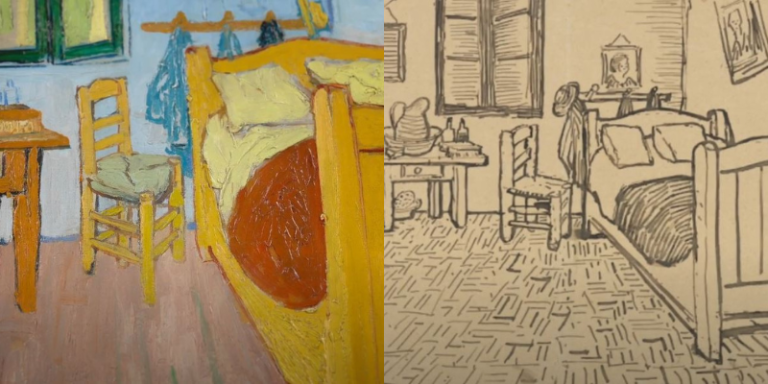One of the most emotionally charged interiors in art history is Vincent van Gogh’s “The Bedroom,” which he painted in October 1888. This piece, which he created while staying at the now-famous Yellow House in Arles, France, provides more than just a visual representation of a room; it also conveys a mental longing for serenity.
The painting turns commonplace furniture into something subtly monumental, with the intention of symbolizing “absolute repose.” Van Gogh’s color scheme, like a lullaby, whispers of loneliness beneath its surface while singing of tranquility.
“The Bedroom” at a Glance
| Feature | Details |
|---|---|
| Artist | Vincent van Gogh |
| Original Painting Date | October 1888 |
| Medium | Oil on canvas |
| Dimensions | 72 x 90 cm (Original, Amsterdam) |
| Museum Locations | Van Gogh Museum, Art Institute of Chicago, Musée d’Orsay |
| Color Palette | Pale lilac walls, yellow bed, red blanket, green window, blue washbasin |
| Symbolism | Calm, solitude, psychological balance |
| Influences | Japanese woodblock prints, post-impressionism |
| Perspective Style | Flattened, distorted for emotional effect |
The Three Versions: Intentional Repetition
Van Gogh produced three different iterations of The Bedroom over time. The original is currently housed in Amsterdam’s Van Gogh Museum. A smaller third canvas is housed at the Musée d’Orsay in Paris, while a slightly altered second version is kept at the Art Institute of Chicago.
Changes in his artistic confidence and mental state are evident in each rendition. Van Gogh saw repeating the same subject as a way to reinforce meaning through recognizable visual rhythms rather than just copying.
An Emotional Color Code
Both physical rest and emotional turmoil were effectively conveyed by Van Gogh’s use of color. He wrote a detailed description of the room in his letter to his brother Theo, including the chrome yellow chairs, the scarlet bedspread, the green window, and the walls, which were originally painted a pale violet but have since faded due to pigment deterioration.
He transformed his private area into a purposefully painted haven by flattening shadows and using color as emotion rather than realism. It’s similar to witnessing a memory change in the light of a candle—familiar but subtly warped.
Flattened Viewpoint, Emotional Depth
Upon initial observation, the room seems strangely drawn. The floor appears to float forward, the walls appear to tilt, and the bed appears to reach out for the observer. This was no coincidence.
Van Gogh purposefully eliminated depth to enhance emotional clarity, drawing inspiration from Japanese ukiyo-e prints. This stylistic decision allowed the painting to hide the chaos that was simmering inside while echoing the visual calm of Eastern minimalism.
A Restless Silence Beneath the Surface
Art historians have long observed a remarkably similar thread of unease running through the composition, despite Van Gogh’s desire for tranquility. The viewer appears to be trapped by the tight, angular arrangement and distorted geometry, which mirrors the painter’s own sense of isolation and entrapment.
This apparently calm interior starts to read more like a haven constructed out of need than out of peace—a stronghold of the mind rather than a haven of solace—in light of his mental health issues.
A Return to Intention and Color
The Bedroom’s original colors have been digitally restored over the last ten years thanks to scientific efforts. Researchers discovered that the walls were originally a soft lilac rather than the glaring blue we see today by using pigment analysis and sophisticated imaging. These restorations provide emotional fidelity in addition to visual accuracy.
Museums are significantly enhancing our understanding of artistic intention by fusing technology with historical records, providing us with a better window into the artist’s initial intent.
Display, Heritage, and International Appeal
In 2016, the three versions of the painting were brought together for the Art Institute of Chicago’s Van Gogh’s Bedrooms exhibition. Similar to reading three drafts of a personal letter to oneself, visitors could compare the subtleties side by side.
Van Gogh’s room speaks to audiences today that are centuries old. This modest portrayal of a bedroom has become surprisingly relevant in a world overtaken by noise and speed—a visual reminder of the importance of quiet.
Why the Bedroom of Van Gogh Is Still Important
It’s not about the bedroom’s furnishings. It’s about the universal human need for safety, which cuts across time and space. Van Gogh struggled with dreams, anxieties, and the transience of peace in his room, which served as more than just a place to sleep.
This subtle duality is what gives it its timeless appeal. The composition of the painting is remarkably clear, but its emotional undertones are complex and eerily human. Van Gogh seems to have included a pause button in his paintings, urging viewers to take a moment to rest, think, and reconnect with themselves.
Using Art as a Shelter
Van Gogh’s “The Bedroom” speaks to contemporary wellbeing not only as a work of art but also as a way of thinking. With its strikingly crooked lines and glowing hues, it serves as a reminder that sometimes the best luxury is just a place to be.
Perhaps this explains why, over a century later, millions of people are still captivated by his artwork as well as the essence of the room he meticulously painted—a private haven that is just waiting to greet us.
FAQs
What inspired Van Gogh’s “Bedroom”?
He wanted to create a sense of rest and calm using color and shape, especially after a period of illness.
Why did he paint it three times?
He created replicas for family and to replace a damaged original—each version with subtle emotional shifts.
Where are the three versions today?
Amsterdam (Van Gogh Museum), Chicago (Art Institute), and Paris (Musée d’Orsay).
What style is the painting influenced by?
Japanese prints—flat, bold, and minimal, with no shadows and vibrant color contrasts.
Did the painting change color over time?
Yes, notably. Digital reconstructions have revealed faded lilac tones that once shaped its mood.


